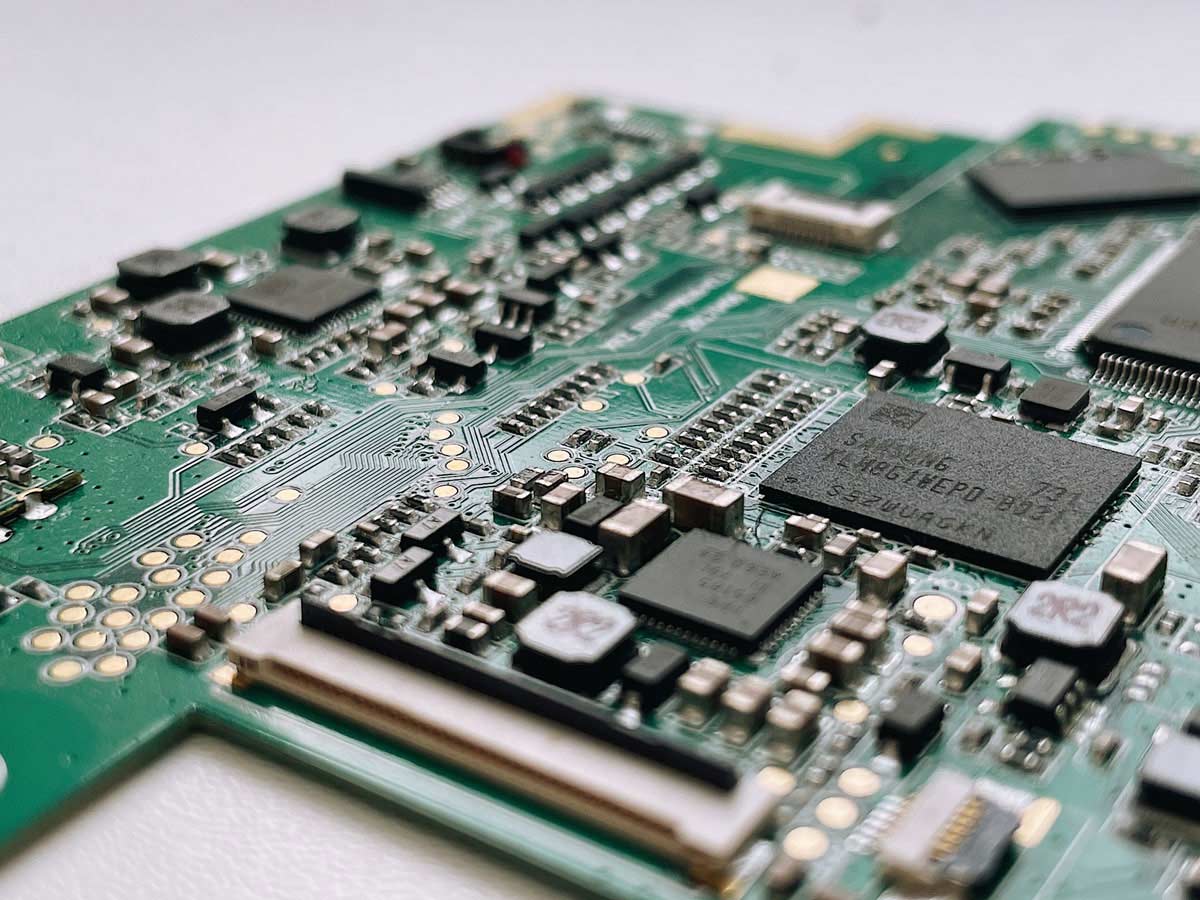Conformal coating doesn’t usually get the spotlight, but we think it should.
It’s one of the last steps in the PCB assembly process and one of the most important. Without it, circuit boards are left exposed to moisture, dust, vibration, and other hazards that can quietly destroy performance over time.
In this post, we’ll break down exactly what conformal coating is, why it matters, how it’s applied, and the materials used to get it right. Whether you’re designing rugged electronics or just want to build smarter, understanding this protective layer is key to long-term reliability.
The Origins of Conformal Coating
Every printed circuit board starts the same way: with a clean sheet of fiberglass, a web of copper traces, and a careful layering of components. Once assembled, these boards become the nerve centers of everything from smartphones to satellites. Whether it’s managing power distribution in a factory or tracking altitude in a jet, PCBs are everywhere.
All that means is that environmental pressure is a given. Vibration. Heat. Cold. Humidity. Dust. Sometimes all of the above at once. A good PCB has to hold up in the clean room and the field, whether it’s in a hospital ventilator or under the hood of a truck.
Small Contaminants, Big Consequences
The problem is that a circuit board, by itself, is vulnerable. Solder joints and conductive paths are vulnerable to flux residue, moisture, dust, and airborne contaminants. Even minor exposure can lead to corrosion, leakage, or electrical shorts.
In Search of a Solution
Given the reality of natural contaminants and the rapidly increasing number of applications for PCBs, a solution was sorely needed. That’s where conformal coating came in.
What Is Conformal Coating?
How do you protect a PCB without redesigning it from the ground up? You give it a second skin.
That’s the role of conformal coating—a thin, transparent layer of polymer that’s applied to the surface of a finished circuit board. It “conforms” to the contours of the board (hence the name), covering everything from solder joints to delicate traces without interfering with functionality.
This coating isn’t meant to seal the board off completely like potting or encapsulation. Instead, it forms a breathable, insulating barrier that dramatically improves durability while keeping the board serviceable and testable.
What Conformal Coating Does
Once applied and cured, conformal coating acts as a protective barrier against a wide range of environmental stressors:
- Moisture and humidity, which can lead to corrosion and conductivity drift
- Dust, dirt, and debris, especially in industrial or outdoor settings
- Chemical exposure, including oils, solvents, and airborne contaminants
- Salt spray, critical in marine or coastal applications
- Electrical arcing, by increasing surface insulation between conductors
- Thermal and mechanical stress, helping components survive vibration and expansion cycles
With this new suit of armor, PCBs can handle a far greater range of environmental pressures and conditions.
The Electrical Advantage
One of the biggest benefits of today’s high-density boards is how conformal coating improves electrical reliability. With components packed tighter than ever, the risk of leakage currents or unintended conduction paths goes up.
A good coating helps:
- Maintain consistent dielectric strength across the board
- Reduce parasitic capacitance and signal distortion
- Prevent micro-arcing between high-voltage traces
- Enable closer spacing of components without increasing failure risk
Given the clear benefits and minimal added production time, cost, and weight, conformal coating is now a must-have for any PCB manufacturer worth its salt.
Why It Matters for Manufacturers
For manufacturers, conformal coating means reducing field failures, extending product life, and protecting brand reputation.
When done right, it can:
- Cut down on returns and warranty claims
- Reduce the need for bulky or expensive enclosures
- Enable boards to operate in a wider range of environments
- Lower the long-term cost of ownership for end users
It’s a relatively small step in the assembly process, but the value it adds, both technically and commercially, is hard to overstate.
How Conformal Coating Works: Process, Materials, and Methods
Conformal coating happens late in the PCB assembly process. By this point, the board has been fabricated, populated with components, soldered, inspected, and tested. But it’s not ready for the field until it’s protected.
Here’s how the typical workflow looks:
1. Board Cleaning
Any leftover flux, fingerprints, or dust is removed. Surface contamination will ruin adhesion and performance. Precision cleaning, often using deionized water washes or vapor degreasers, is non-negotiable.
2. Masking
Not everything on a PCB should be coated. Connectors, test pads, edge contacts, and heat sinks are typically masked off using tape, boots, or peelable masks. The accuracy of this step directly affects downstream usability and reworkability.
3. Application
This is where automation meets expertise. Depending on volume and geometry, conformal coating is applied by spray, dip, brush, or (in high-end cases) vapor deposition. Selective coating machines—robotic systems with needle-precise control—are often used to target specific areas while avoiding masked components.
4. Curing
Once applied, the coating must cure under controlled conditions. Some materials air-cure; others require UV or thermal curing. Timing, temperature, and humidity all need to be managed to avoid surface defects, bubbling, or incomplete polymerization.
5. Inspection
Every coated board is examined under both visible and UV light. The goal is full, even coverage without bubbles, bridging, or thin spots. Some manufacturers also perform cross-section analysis, adhesion testing, or even dielectric strength testing to validate the protective layer.
Choosing the Right Coating
Different coatings solve different problems. There’s no one-size-fits-all formula.
Here’s a quick breakdown:
Acrylics
Most commonly used in consumer electronics, general industrial products, and any environment where moderate protection is enough.
Acrylic coatings are thermoplastic resins that cure through solvent evaporation. They’re easy to apply, quick to dry, and just as easy to remove, making them ideal for high-turnover products or boards that may need rework down the line.
Silicones
These offer excellent moisture and UV resistance, which helps in outdoor or high-condensation environments.
Silicone-based coatings are formed from polysiloxanes, known for their elasticity and resistance to high heat. These coatings remain flexible even at extreme temperatures, making them well-suited for automotive engine compartments, aerospace systems, and LED lighting.
Polyurethanes
These are often chosen for industrial, defense, or transportation applications where the electronics face regular chemical exposure.
Polyurethane coatings are tough, two-part chemistries with strong chemical and abrasion resistance. Once cured, they form a hard, durable shell that’s difficult to remove but excellent for withstanding solvents, fuel vapors, and other aggressive contaminants.
Parylenes
Medical implants, aerospace instruments, and precision sensors often rely on parylene when nothing else will do.
Parylene is a vapor-deposited polymer that forms a uniform, pinhole-free coating at the molecular level. It’s applied in a vacuum chamber using a chemical vapor deposition (CVD) process, making it ideal for protecting high-value or miniaturized electronics.
Selecting the right conformal coating is only part of the equation. Just as important is having a manufacturing partner who knows how to apply it with precision, consistency, and the right process controls.
Imagineering’s Expertise in Conformal Coating = Your Product’s Reliability
Conformal coating isn’t just a finishing, but also a critical line of defense for modern electronics. It protects PCBs from harsh environments, improves electrical performance, and helps manufacturers reduce costly failures in the field.
At Imagineering, we don’t treat conformal coating as an afterthought. We integrate it into our process with precision, automation, and materials expertise to ensure your boards perform reliably, no matter where they’re headed.
If you’re looking for a PCB manufacturer that understands the details, we’re ready to help. Reach out today to start a conversation about your next build.

